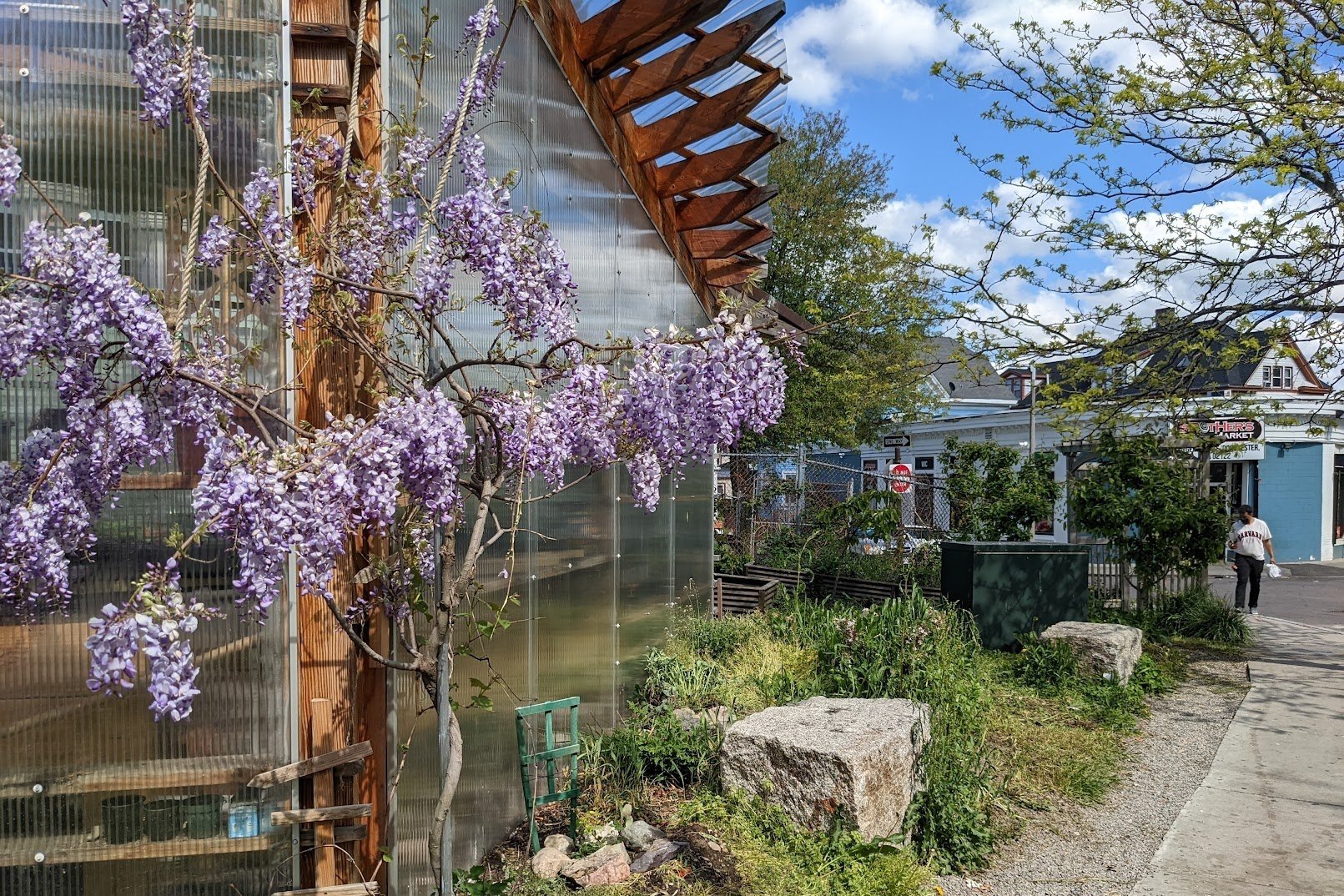
In the Media
UVM Institute for Agroecology
Food Forests Play Critical Role in Building Community & Advancing Right to Food
Article by Amanda Hutson, December 2025.
Robin Greenfield Channel
Food Forests are popping up in Boston!
Video by Robin Greenfield, October 2025.
The Boston Globe
Rising ‘Food Forests’ Bring Free Fruit and Heat Relief to Boston’s Neighborhoods
Article by Ryan Krugman, October 2025.
Inside Climate News
Boston’s Food Forests Take Root as a Climate Equity Strategy
Article by Ryan Krugman, October 2025.
From the Ground Up (Wildlands, Woodlands, Farmlands & Communities)
The Hidden World of Boston’s Food Forests
Segment by Hope Kelley, September 2025.
WBZ/CBS News — Levan Out Live
Food Forests in Boston Do More Than Just Feed The Community
Segment by Levan Reid, September 2025.
WBZ/CBS News — Levan Out Live
Neighbors Join Forces to Create "Food Forests" in Boston
Segment by Levan Reid, September 2025.
Boston College
Research Thesis by Alex Eduardo, Forest Kuestner-Burleson, & Hsiu Tsao; August 2025.
Boston Neighborhood Network Media
Flourishing Food Forest Opens in Grove Hall
Segment by Boston Neighborhood Network, July 2025.
CBS/WBZ
Community Food Forest to Open in Boston’s Grove Hall Neighborhood
Segment by CBS/WBZ, June 2025.
AXIOS Boston
What’s Behind the Rise of Urban Food Forests Around Boston
Article by Steph Solis, June 2025.
Down to Earth: The Planet to Plate Podcast
Cultivating Community in Urban Food Forests
Episode by Radio Café, June 2025.
Boston University Pardee Center News
Pardee Center Hosts Two-Day Workshop Exploring the Future of Food
Article by BU Pardee Center News, April 2025.
Life Science Cares: Moving Forward, Giving Back Podcast
Health Equity: What. Big Concept Really Means to Our Community
Episode by Life Science Cares, April 2025.
Expert Banter Podcast
E16: Food Forests | Orion Kriegman, Boston Food Forest Coalition
Episode by Nathan Shnaider, February 2025.
The New Green Documentary Series
Episode 4: Boston in the Age of the Anthropocene
Video by Naémie, January 2025.
From the Ground Up (Wildlands, Woodlands, Farmlands & Communities)
“Beyond the Supply Chain: Building Local Food Resilience Through Relationship”
Article by Hope Kelley, December 2024.
Federal Emergency Management Agency (FEMA)
“Planting Resilience in the Hearts of Bostonians”
Video by FEMA, December 2024.
Christian Science Monitor
“Food forests rise in Boston. Edible lots create green space – and community.”
Article by Sophie Ungerleider & Melanie Stetson Freeman, August 2024.
Tufts University
Thesis by Hannah Gruber, August 2024.
CBS
“Edgewater Food Forest in Mattapan Gives Neighbors Healthier Options”
Video by CBS News, August 2024.
Social Innovation Forum (SIF)
“An Evening of Elevating Impact in Local Communities”
Article by SIF Team, May 2024.
Dorchester Reporter
“A Food Forest Takes Root on a Jones Hill Side Street”
Article by Taylor Brokesh, April 2024
The BTS Center
“Cultivating Earth-Shaped Leadership: Ecological Imagination in Organizational Life”
Report by the BTS Center of Maine, February 2024.
Bay State Banner
“City’s community garden program supports fresh food, environmental benefits”
Article by Avery Bleichfeld, January 2024.
Social Innovation Forum (SIF)
“SIF Announces 2024 Social Innovator Cohort”
Article by SIF Team, December 2023.
The Boston Globe
“Green spaces in Boston are blooming: Here’s what it means to Bostonians”
Article by Jaimie Seaton, October 2023.
Food Solutions New England (FSNE)
“A Just Transition in Agriculture and Soil Health for Regional Climate Resilience”
Issue Brief by Julie Snorek, Julie Davenson, Karen Nordstrom, Shane Rogers & Hope Kelley; August 2023.
WBUR, The Common
“From the newsroom: A 'food forest' in Mattapan is a space to harvest food and grow community”
Audio-postcard by Zeninjor Enwemeka & Katelyn Harrop; July 2023.
WGBH
“Offering free food and shade, ‘food forests’ are sprouting up in Boston”
Article and recording by Jessie Steinmetz, July 2023.
Natural Awakenings Magazine
“Boston’s Food Forest Expansion”
Article by Wendy Nadherny Fachon, July 2023.
The Forest Garden Podcast
“The Boston Food Forest Coalition with Nellie Ward and Alex Alvanos”
Podcast by Ben Bishop & Mike Amato, June 2023.
Christian Science Monitor
“A Boston ‘edible park’ plants caring and community”
Article by Kendra Nordin Beato, June 2023.
WBUR
“New 'food forest' in Mattapan a space to harvest food and grow community”
Article by Barbara Moran, May 2023.
The Boston Globe
“A ‘food forest’ rises on an empty Mattapan lot, and draws a visit from the mayor”
Article by Sean Cotter, May 2023.
Institute for Nonprofit Practice
By IFNP Staff, May 2023.
The Conversation
“Food forests are bringing shade and sustenance to US cities, one parcel of land at a time”
By Karen Spiller & Prakash Kashwan, April 2023.
Social Innovation Forum
“SIF Announces the 2023 Finalists for the Social Innovator Accelerator”
By The SIF Team, November 2022.
Great Transition Initiative
“Urban Grassroots: Conservation at the Crossroads”
By Orion Kriegmen, May 2022.
Boston.gov
“Food Forests: Learn More About Food Forests and Where to Find Them In Boston”
By The Mayor’s Office of Food Justice, March 2022.
Integrative & Complementary Therapies Vol. 28, No. 1
“Boston Food Forest Coalition: Uniting Nature and Neighborhoods”
By Orion Kriegman, February 2022.
Haverford College
“Orion Kriegman ‘96: Perfecting the Recipe for Urban Food Forests”
By Haverford College, January 2022.
Dorchester Reporter
“Saturday: Volunteers gather in Mattapan.
This week: A garden grows on Burmah Street”
By Daniel Sheehan, April 2021.
Edible Boston Magazine
By Michael Floreak, 2020.
Dorchester Reporter
“He’s on a Mission to Turn Boston into a Collection of Food Forests”
By Rowan Walrath, 2018.
Inhabitat Magazine
“Boston Food Forest Inspires Community through Ecological Design”
By Greg Beach, 2015.
The Christian Science Monitor
“A Visionary’s Quest: A City Filled With Gardens”
By David Hugh Smith, 2015.




















































